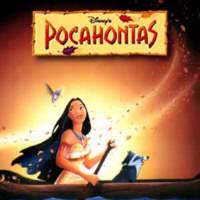 |
| Pocahontas |
| Disney's Pocahontas is one of my favourite stories. Animations, whatever. I was shaken when the first time I saw it and got a ending where the lovers couldn't be together. It was such a shock in a fairy tale, particularly the lovable Pocahontas. Then when I rewatched and rewatched the movie, I knew that it was probably better that way, that she was better off staying with Nature; while it was pretty sad for John Smith, who, according to himself, "didn't really belong there (in Jamestown; modern world)". No worries, Pocahontas 2 has come out. I didn't watch the sequel, so no comment. I don't really want a sequel because it could try to make ends meet and make up some super ridiculous storylines. I am contented with the first one, just don't break my dream. If I were Pocahontas, I wouldn't want to stay in the new modern world John Smith had to show, so there would be another goodbye. That would be too sad. |
| Disney's Pocahontas 1: Pocahontas rode a raft on the river when her father proposed that she married to Kocoum. She was struggling with her destiny, with her loyal friend, Meeko, by her side. |
| The reasons why I like Disney's Pocahontas so much is that it put across a message of the beauty of Nature which people who think they are civilized and non-savage and modern and stuff often miss out. They (the capitalists) have dollar signs in their thick spectacles and can't see things straight. In the movie, Pocahontas (who could see Nature's beauty, like when she talked to the old willow tree) was the messenger John Smith (the colonizer who like the others thought they were the saviour to "savage people") destined to meet so that the "civilized" could too learn to appreciate Nature's beauty. The part I like most about the movie was when the old willow tree told Pocahontas to listen with her heart so she would understand Nature's call to her about her destiny. Another part was when Pocahontas cruised the whole territory with John Smith, showing him how beautiful Nature was, and the music put a great influence on people, too! Disney's Pocahontas was more a Nature lover. That is Disney's magic, to draw a person to a complete differnt personality. In reality, Pocahontas was much younger (just around 11 when she met Captain John Smith) and Smith was not as handsome and sexy as protrayed in the flick! Well, hear the true story. |
 |
| Pocahontas: the true story Pocahontas in Disney was a beautiful and passionate woman. Born to be the same as the real Pocahontas, she was an Indian princess, the daughter of a powerful chief of the Algonquian Indians called Powhatan. She was named Matoaka by her mother, who was one of the many wives of Powhatan. But she was better known as Pocahontas, the playful, frolicsome little girl. She met white men for the first time in May 1607, one of those was Captain John Smith. It was doubted that the meeting of Pocahontas and John Smith was romanticized, if not entirely invented, by John Smith. According to him, when he went to the residence of Powhatan at Werowocomoco, "he was first welcomed by the great chief and offered a feast. Then he was grabbed and forced to stretch out on two large, flat stones. Indians stood over him with clubs as though ready to beat him to death if ordered. Suddenly a little Indian girl rushed in and took Smith's head in her arms and laid her own upon his to save him from death. (just like in Disney's Pocahontas)" Actually, this mock "execution and salvation" was a ritual for the Indians, that means, Pocahontas' actions were probably a part of a ritual, too! Anyway, Pocahontas and John became friends. Pocahontas admired John Smith very much and always went chat with him during her visits to Jamestown, where Smith lived. The admiration was returned. However, the worsened relation between the white colonizers and Powhatans made Pocahontas' visits to the fort much lessen. In October, 1609, when Pocahontas next went to visit the fort, she was told that John Smith was dead. Pocahontas then married an Indian "pryvate Captayne" named Kocoum (the unsmiling guy in Disney's Pocahontas) in 1610. Later, Englishman Samuel Argall, kidnapped her with the help of Japazaws, lesser chief of the Patowomeck Indians, and held her for the ransom of the English prisoners Powhatan was holding, the arms and tolls that the Indians had stolen, and also some CORN. (...!) Captain Samuel Argall returned to Jamestown in 1613 with Pocahontas and she was settled in Henrico, where she began her education in the Christian Faith, and that she met John Rolfe, a successful tobacoo planter. Sir Thomas Dale, the leader of the city of Henrico, later brought Pocahontas into Powhatan's territory to claim her entire ransom. There, Pocahontas TOLD her brothers and father that she was in love with the Englishman John Rolfe and would like to marry him. After Powhatan giving his consent, the Englishmen left with delight at the prospect of the "peace-making" marriage without receiving the full ransom. John Rolfe would only marry a "strange wife", a healthen Indian if she would be converted to Christianity. Pocahontas then was baptized and christened Rebecca, and married John Rolfe in 1614. A general peace and a spirit of goodwill between the English and the Indians resulted from this marriage. In 1617, when Pocahontas' husband decided to bring her back to his family in Virginia, she knew she would not survive the voyage. She was deathly ill from Pneumonia (or possibly tuberculosis). When she was taken ashore, she comforted her husband when dying. She said "All must die. 'Tis enough that the child liveth." She was buried in England. She was 22 years old. |
| Romance blossoms in Disney's Pocahontas (a great commentary) |